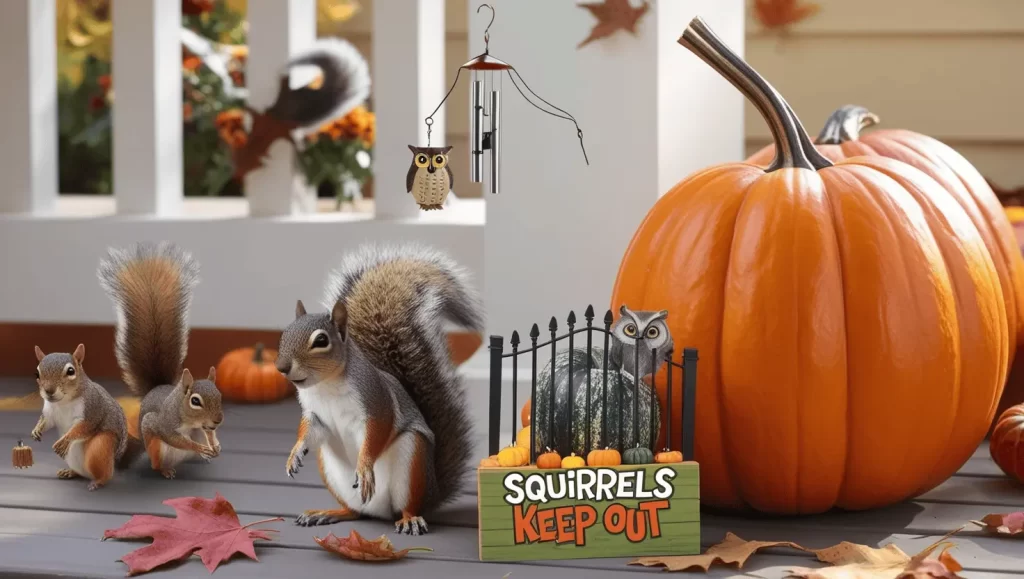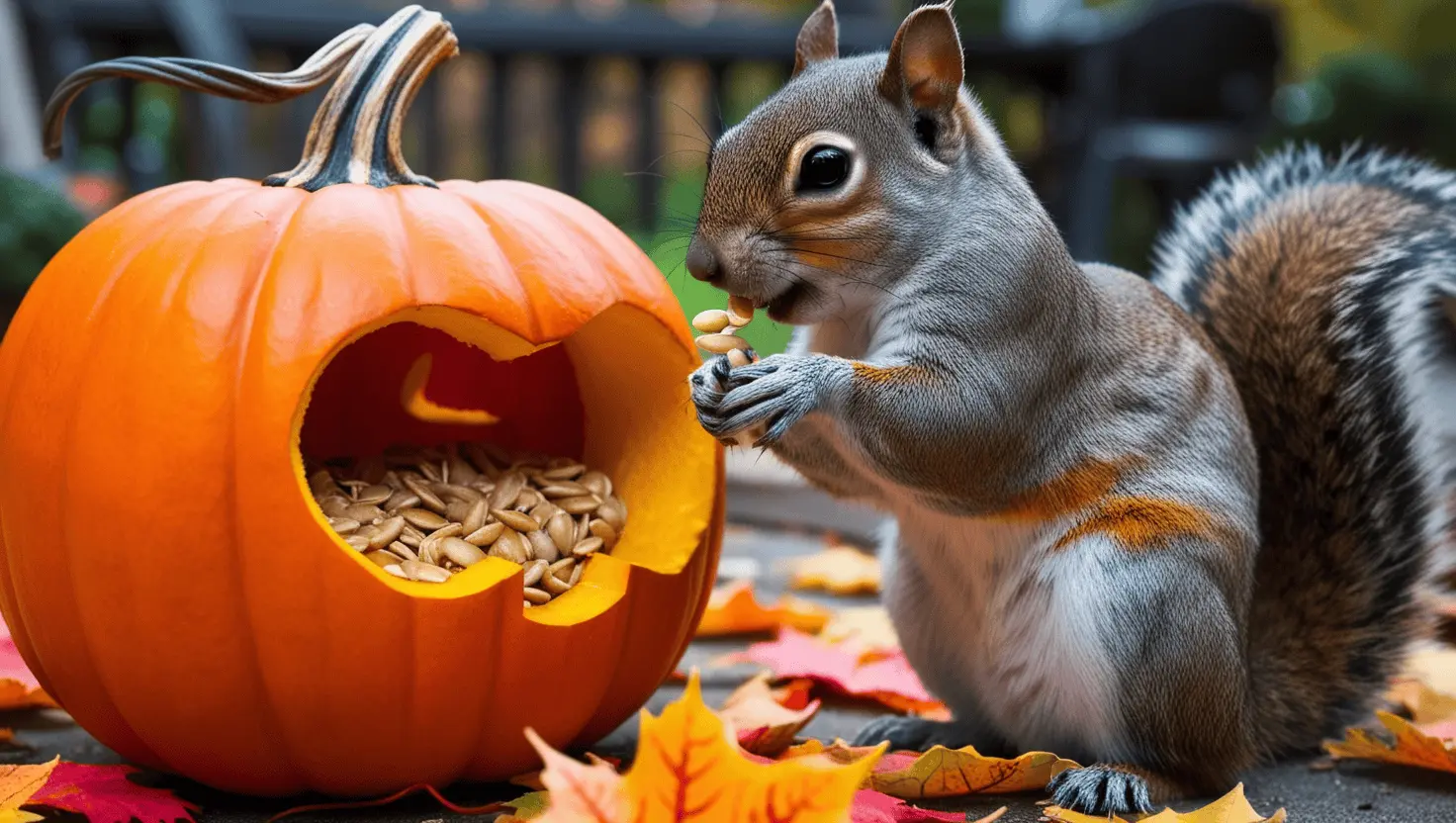Pumpkins are a symbol of fall, adorning porches and gardens with their vibrant orange hue. However, as beautiful as they are, pumpkins also attract unwanted visitors like squirrels, who seem to view your carefully grown pumpkins as a delightful snack. These clever rodents can wreak havoc on your fall decorations and garden, leaving behind chewed-up pumpkins and frustration. Luckily, there are effective, safe ways to protect your pumpkins and ensure they remain intact throughout the season. Below are ten proven methods to keep squirrels away from your pumpkins.
1. Keep Your Yard Clutter-Free
Squirrels love to hide and forage in cluttered spaces. Keeping your yard clean and free of debris will discourage them from making your property their feeding ground. Rake leaves regularly and remove any piles of brush or overgrown plants where squirrels may find shelter. In addition to making your yard look tidier, this will make it less inviting for squirrels.
To go a step further, consider removing bird feeders or switching to squirrel-proof models. Bird feeders attract squirrels with their easy-to-access seeds, making your yard more appealing. By eliminating these food sources, you’ll reduce the likelihood of squirrels coming near your pumpkins.
2. Use Electric Fencing
Although squirrels are agile climbers, adding a layer of protection to your garden can make a big difference. Installing electric fencing around your pumpkins creates a barrier that discourages squirrels from getting too close. This method may not be suitable for urban areas, as it could create conflicts with neighbors or pose a risk to pets and children. However, in larger, open spaces, electric fencing can be an excellent deterrent.
Make sure the fence is tall enough to prevent squirrels from jumping over and properly maintained to ensure it remains effective throughout the fall season.
3. Cover Pumpkins with Netting or Cloches
Wire cloches or netting can offer physical protection for your pumpkins. Covering your pumpkins with these materials prevents squirrels from gnawing on them. Ensure that the netting has a fine mesh to stop squirrels from squeezing through, and stake it securely to the ground so they can’t push it aside.
While this method is great for pumpkins in the garden, it may not be ideal if you’re using pumpkins for display on your porch. If you do choose to use it, make sure the materials blend in well with your fall décor.

4. Apply Homemade or Commercial Repellents
Squirrels are sensitive to strong smells and tastes, so squirrel repellents can be a powerful tool. Several commercial repellents are available, but you can also create homemade solutions that are just as effective. Capsaicin-based repellents (made from chili pepper extract) are particularly useful. The spicy taste will deter squirrels from biting into your pumpkins without harming the animals.
If you’re looking for a homemade solution, try coffee grounds, garlic, or peppermint oil around your pumpkins. These strong odors may keep squirrels at bay, though it may take some trial and error to find what works best in your garden. Just remember to reapply after rain, as the scent can fade quickly.
5. Attract Natural Predators
Encouraging the presence of natural predators can help keep the squirrel population under control. Birds of prey like hawks and owls, along with animals like foxes and coyotes, can help naturally limit the number of squirrels in your yard. To attract these predators, consider installing a perching pole for birds of prey or simply allow them to frequent your property without disturbance.
If you have a dog, letting it roam your yard freely can also be an excellent deterrent. The sight and smell of a predator can be enough to make squirrels think twice about approaching your pumpkins.
6. Use Noise Makers
Noise deterrents can also help scare squirrels away from your pumpkins. Items like wind chimes, recordings of predator calls, or portable radios playing talk shows can create a disruptive environment for squirrels, making them less likely to stick around.
However, it’s essential to move these items around from time to time. Squirrels can quickly get used to stationary objects and sounds, rendering the deterrents less effective. Be mindful of using noise deterrents in urban areas, as they could disturb neighbors or violate noise ordinances.
7. Visual Deterrents
Visual scare tactics can also be effective in keeping squirrels away from your pumpkins. Items like shiny mylar tape, reflective pinwheels, or even fake predator decoys (like plastic owls or hawks) can give squirrels the impression that danger is near. These deterrents work best when they’re positioned in areas where squirrels are most likely to approach.
Consider using reflective objects that move in the wind, as they catch light and create sudden flashes, scaring the squirrels away. Strobe lights can also serve a dual purpose: deterring squirrels while contributing to your spooky Halloween decorations.
8. Install Motion-Activated Sprinklers or Lights
One of the most effective ways to protect your pumpkins is by using motion-activated sprinklers or lights. These devices activate when they detect movement, startling squirrels with a sudden spray of water or a bright flash of light. Not only does this protect your pumpkins, but it can also prevent other pests from damaging your garden.
Be sure to position the sprinklers or lights carefully to avoid accidentally spraying mail carriers or passersby. Also, adjust the range of motion detection so that it only targets the areas near your pumpkins.
9. Trap and Relocate
If squirrels continue to damage your pumpkins despite your best efforts, trapping and relocating them can be a last resort. However, this method should only be used after consulting local wildlife regulations. In many areas, it’s illegal to relocate squirrels far from their original habitat.
Trapping should be done humanely, using live traps and ensuring that the animals are released into a safe environment. Additionally, once a squirrel is removed, it’s essential to continue using deterrents to prevent new squirrels from moving in.
10. Seek Professional Help
If you’re dealing with an overwhelming squirrel problem, it’s worth considering professional wildlife control. Experts can inspect your yard, identify problem areas, and recommend a comprehensive strategy to keep squirrels away from your pumpkins. They can also safely and humanely handle any relocation efforts, ensuring that local regulations are followed.
Professional help can be especially useful if squirrels are causing extensive damage to your property or if you’re unable to manage the problem with DIY methods.
By using a combination of these methods, you can effectively protect your pumpkins from squirrels this fall. Whether you’re looking for physical barriers, repellents, or natural deterrents, there’s a solution that will fit your needs. Keeping your yard clean, using sensory deterrents, and even attracting predators are all part of a comprehensive strategy to safeguard your pumpkins and enjoy a beautiful fall display without the worry of squirrel damage.

